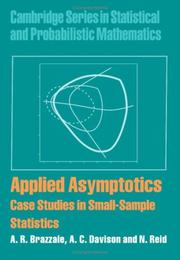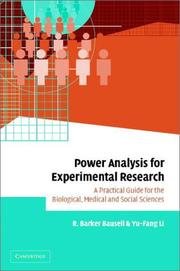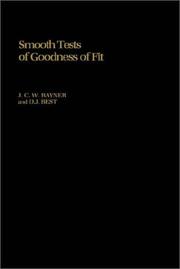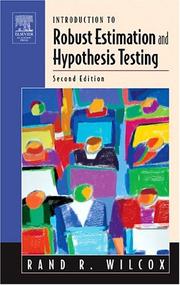| Listing 1 - 10 of 53 | << page >> |
Sort by
|

ISBN: 9780521847032 0521847036 9780511611131 9780511286704 0511286708 0511284403 9780511284403 0511285221 9780511285226 0511285981 9780511285981 0511611137 1107175615 1280909897 9786610909896 0511322224 Year: 2007 Publisher: Cambridge : Cambridge University Press,
Abstract | Keywords | Export | Availability | Bookmark
 Loading...
Loading...Choose an application
- Reference Manager
- EndNote
- RefWorks (Direct export to RefWorks)
In fields such as biology, medical sciences, sociology, and economics researchers often face the situation where the number of available observations, or the amount of available information, is sufficiently small that approximations based on the normal distribution may be unreliable. Theoretical work over the last quarter-century has led to new likelihood-based methods that lead to very accurate approximations in finite samples, but this work has had limited impact on statistical practice. This book illustrates by means of realistic examples and case studies how to use the new theory, and investigates how and when it makes a difference to the resulting inference. The treatment is oriented towards practice and comes with code in the R language (available from the web) which enables the methods to be applied in a range of situations of interest to practitioners. The analysis includes some comparisons of higher order likelihood inference with bootstrap or Bayesian methods.
Statistical hypothesis testing --- Asymptotic theory. --- Mathematics. --- Math --- Science --- Asymptotic theory in statistical hypothesis testing --- Asymptotic expansions
Book
ISBN: 3030705773 3030705781 Year: 2022 Publisher: Cham, Switzerland : Springer International Publishing,
Abstract | Keywords | Export | Availability | Bookmark
 Loading...
Loading...Choose an application
- Reference Manager
- EndNote
- RefWorks (Direct export to RefWorks)
Book
ISBN: 9781462525676 1462525679 Year: 2016 Publisher: New York, New York ; London, [England] : The Guilford Press,
Abstract | Keywords | Export | Availability | Bookmark
 Loading...
Loading...Choose an application
- Reference Manager
- EndNote
- RefWorks (Direct export to RefWorks)
Examining the major approaches to hypothesis testing and model selection, this book blends statistical theory with recommendations for practice, illustrated with real-world social science examples. It systematically compares classical (frequentist) and Bayesian approaches, showing how they are applied, exploring ways to reconcile the differences between them, and evaluating key controversies and criticisms. The book also addresses the role of hypothesis testing in the evaluation of theories, the relationship between hypothesis tests and confidence intervals, and the role of prior knowledge in Bayesian estimation and Bayesian hypothesis testing. Two easily calculated alternatives to standard hypothesis tests are discussed in depth: the Akaike information criterion (AIC) and Bayesian information criterion (BIC)
Social sciences --- Statistical hypothesis testing. --- Statistical methods. --- Methodology.
Book
ISBN: 1503603040 9781503603042 9781503601901 1503601900 9781503603035 1503603032 Year: 2020 Publisher: Stanford, CA : Stanford University Press,
Abstract | Keywords | Export | Availability | Bookmark
 Loading...
Loading...Choose an application
- Reference Manager
- EndNote
- RefWorks (Direct export to RefWorks)
Advocates within the growing field of children's rights have designed dynamic campaigns to protect and promote children's rights. This expanding body of international law and jurisprudence, however, lacks a core text that provides an up-to-date look at current children's rights issues, the evolution of children's rights law, and the efficacy of efforts to protect children. Campaigning for Children focuses on contemporary children's rights, identifying the range of abuses that affect children today, including early marriage, female genital mutilation, child labor, child sex tourism, corporal punishment, the impact of armed conflict, and access to education. Jo Becker traces the last 25 years of the children's rights movement, including the evolution of international laws and standards to protect children from abuse and exploitation. From a practitioner's perspective, Becker provides readers with careful case studies of the organizations and campaigns that are making a difference in the lives of children, and the relevant strategies that have been successful—or not. By presenting a variety of approaches to deal with each issue, this book carefully teases out broader lessons for effective social change in the field of children's rights.
Book
ISBN: 1438466161 9781438466163 9781438466156 1438466153 Year: 2017 Publisher: London, [England] ; New York : Routledge,
Abstract | Keywords | Export | Availability | Bookmark
 Loading...
Loading...Choose an application
- Reference Manager
- EndNote
- RefWorks (Direct export to RefWorks)
Finalist for the 2017 National Jewish Book Award in Modern Jewish Thought and Experience presented by the Jewish Book CouncilMovies and Midrash uses cinema as a springboard to discuss central Jewish texts and matters of belief. A number of books have drawn on films to explicate Christian theology and belief, but Wendy I. Zierler is the first to do so from a Jewish perspective, exploring what Jewish tradition, text, and theology have to say about the lessons and themes arising from influential and compelling films. The book uses the method of "inverted midrash": while classical rabbinical midrash begins with exegesis of a verse and then introduces a mashal (parable) as a means of further explication, Zierler turns that process around, beginning with the culturally familiar cinematic parable and then analyzing related Jewish texts. Each chapter connects a secular film to a different central theme in classical Jewish sources or modern Jewish thought. Films covered include The Truman Show (truth), Memento (memory), Crimes and Misdemeanors (sin), Magnolia (confession and redemption), The Descendants (birthright), Forrest Gump (cleverness and simplicity), and The Hunger Games (creation of humanity in God's image), among others.

ISBN: 1107131820 1280433795 9786610433797 0511331258 1139147560 0511170416 0511064039 0511057709 0511541937 051107249X 9780511064036 9780511057700 9780511072499 9780511170416 9780511541933 9780521809160 0521809169 0521809169 9781280433795 9781107131828 6610433798 9780511331251 9781139147569 9780521024563 0521024560 Year: 2002 Publisher: Cambridge ; New York : Cambridge University Press,
Abstract | Keywords | Export | Availability | Bookmark
 Loading...
Loading...Choose an application
- Reference Manager
- EndNote
- RefWorks (Direct export to RefWorks)
Power analysis is an essential tool for determining whether a statistically significant result can be expected in a scientific experiment prior to the experiment being performed. Many funding agencies and institutional review boards now require power analyses to be carried out before they will approve experiments, particularly where they involve the use of human subjects. This comprehensive, yet accessible, book provides practising researchers with step-by-step instructions for conducting power/sample size analyses, assuming only basic prior knowledge of summary statistics and the normal distribution. It contains a unified approach to statistical power analysis, with numerous easy-to-use tables to guide the reader without the need for further calculations or statistical expertise. This will be an indispensable text for researchers and graduates in the medical and biological sciences needing to apply power analysis in the design of their experiments.
Medicine --- Statistical power analysis. --- Power analysis (Statistics) --- Statistical hypothesis testing --- Health Workforce --- Research --- Statistical methods.

ISBN: 1280440600 9786610440603 1423735447 0195363604 1601297122 9781423735441 9781601297129 9780195056105 0195056108 9781280440601 0195056108 6610440603 9780195363609 Year: 1989 Publisher: New York ; Oxford, [England] : Oxford University Press,
Abstract | Keywords | Export | Availability | Bookmark
 Loading...
Loading...Choose an application
- Reference Manager
- EndNote
- RefWorks (Direct export to RefWorks)
This study describes the validity of models involving statistical distribution of data. The smooth tests are a subset of these tests which are easy to apply and can be used in any situation in which there are relatively large sample sizes.
Goodness-of-fit tests. --- Tests, Goodness-of-fit --- Statistical hypothesis testing

ISBN: 1281227323 9786611227326 008047053X 9780080470535 0127515429 Year: 2005 Publisher: Amsterdam ; Boston : Elsevier/Academic Press,
Abstract | Keywords | Export | Availability | Bookmark
 Loading...
Loading...Choose an application
- Reference Manager
- EndNote
- RefWorks (Direct export to RefWorks)
This revised book provides a thorough explanation of the foundation of robust methods, incorporating the latest updates on R and S-Plus, robust ANOVA (Analysis of Variance) and regression. It guides advanced students and other professionals through the basic strategies used for developing practical solutions to problems, and provides a brief background on the foundations of modern methods, placing the new methods in historical context. Author Rand Wilcox includes chapter exercises and many real-world examples that illustrate how various methods perform in different situations.Introd
Estimation theory. --- Robust statistics. --- Statistical hypothesis testing. --- Hypothesis testing (Statistics) --- Significance testing (Statistics) --- Statistical significance testing --- Testing statistical hypotheses --- Distribution (Probability theory) --- Hypothesis --- Mathematical statistics --- Statistics, Robust --- Estimating techniques --- Least squares --- Stochastic processes
Book
ISBN: 9780323952859 9780323952842 0323952852 0323952844 Year: 2023 Publisher: London, United Kingdom : Academic Press is an imprint of Elsevier,
Abstract | Keywords | Export | Availability | Bookmark
 Loading...
Loading...Choose an application
- Reference Manager
- EndNote
- RefWorks (Direct export to RefWorks)
"Wise Use of Null Hypothesis Tests is a user-friendly handbook meant for practitioners. Rather than overwhelming the reader with endless mathematical operations that are rarely performed by hand, the author emphasizes concepts and reasoning. In Wise Use of Null Hypothesis Tests, the author explains what is accomplished by testing null hypotheses--and what is not. The author explains the misconceptions that concern null hypothesis testing. He explains why confidence intervals show the results of null hypothesis tests. Most importantly, the author explains the Big Secret. Many--some say all--null hypotheses must be false. But authorities tell us we should test false null hypotheses anyway to determine the direction of a difference that we know must be there (a topic unrelated to so-called one-tailed tests). In Wise Use of Null Hypothesis Tests, the author explains how to control how often we get the direction wrong (it is not half of alpha) and commit a Type III (or Type S) error."--
Mathematical statistics. --- Statistical hypothesis testing. --- Hypothesis testing (Statistics) --- Significance testing (Statistics) --- Statistical significance testing --- Testing statistical hypotheses --- Distribution (Probability theory) --- Hypothesis --- Mathematical statistics --- Mathematics --- Statistical inference --- Statistics, Mathematical --- Statistics --- Probabilities --- Sampling (Statistics) --- Statistical methods
Book
Year: 2016 Publisher: Chicago : University of Chicago Press,
Abstract | Keywords | Export | Availability | Bookmark
 Loading...
Loading...Choose an application
- Reference Manager
- EndNote
- RefWorks (Direct export to RefWorks)
From eminent biologists like Alfred Russel Wallace and Charles Darwin to famous authors such as Rudyard Kipling in his Just So Stories, many people have asked, "Why do zebras have stripes?" There are many explanations, but until now hardly any have been seriously addressed or even tested. In Zebra Stripes, Tim Caro takes readers through a decade of painstaking fieldwork examining the significance of black-and-white striping and, after systematically dismissing every hypothesis for these markings with new data, he arrives at a surprising conclusion: zebra markings are nature's defense against biting fly annoyance. Popular explanations for stripes range from camouflage to confusion of predators, social facilitation, and even temperature regulation. It is a serious challenge to test these proposals on large animals living in the wild, but using a combination of careful observations, simple field experiments, comparative information, and logic, Caro is able to weigh up the pros and cons of each idea. Eventually-driven by experiments showing that biting flies avoid landing on striped surfaces, observations that striping is most intense where biting flies are abundant, and knowledge of zebras' susceptibility to biting flies and vulnerability to the diseases that flies carry-Caro concludes that black-and-white stripes are an adaptation to thwart biting fly attack. Not just a tale of one scientist's quest to solve a classic mystery of biology, Zebra Stripes is also a testament to the tremendous value of longitudinal research in behavioral ecology, demonstrating how observation, experiment, and comparative research can together reshape our understanding of the natural world.
Zebras --- Stripes. --- Protective coloration (Biology) --- Color. --- adaptive significance. --- black and white coloration. --- equids. --- evolution. --- hypothesis testing. --- zebras.
| Listing 1 - 10 of 53 | << page >> |
Sort by
|

 Search
Search Feedback
Feedback About UniCat
About UniCat  Help
Help News
News